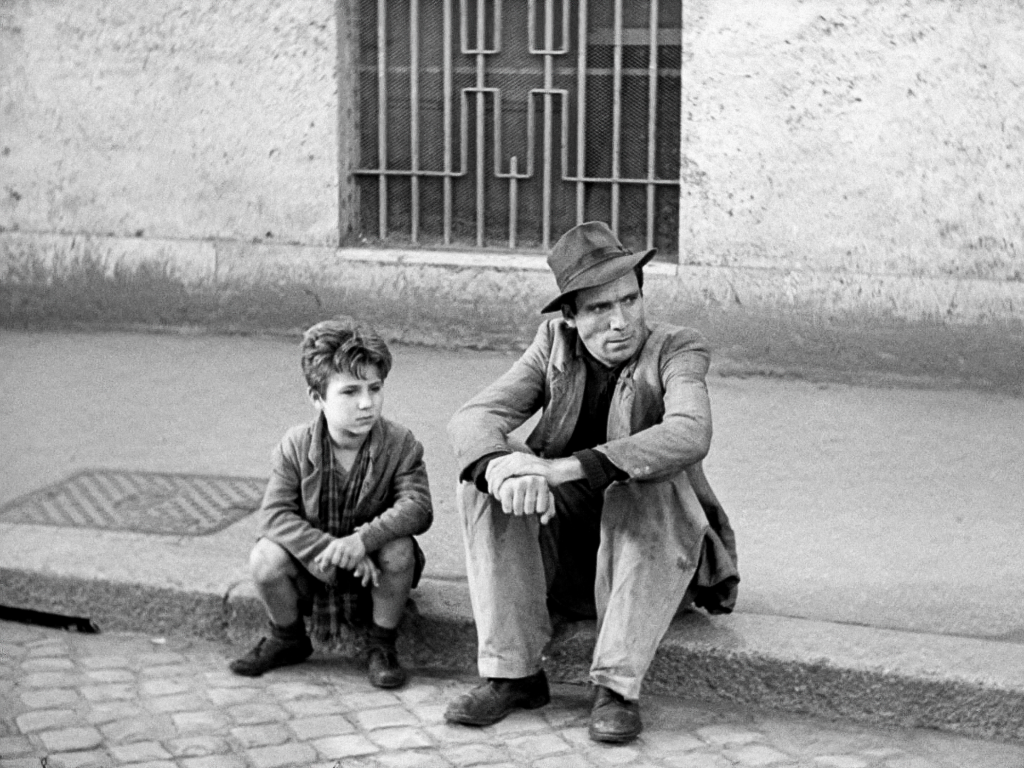Written By: Francesca Newson
Vittorio Di Sica’s 1948 film, Bicycle Thieves, provides a profoundly moving and accurate snapshot into post-war Italian society. Shot using non-professional actors and almost exclusively on the streets of Rome following World War II, Di Sica’s film authentically represents life during an economically damaged society, devastated by an enduring war.
Produced in 1948, Cesare Zavattini’s script tells the story of a workman named Antonio who is in the search of his stolen bicycle accompanied by his young son, Bruno. Without the bicycle, Antonio cannot make a living for his family. The simplicity of the plot speaks to the audience of the desperation of the human experience. Di Sica goes beyond showing the genuine living conditions of Rome, a city in crisis in those post-war years, by narrating Antonio’s individual experience affected by economic collapse as he struggles to make ends meet.
Bicycle Thieves was one of the first films in the Italian neorealism tradition, cementing and popularising the genre. Neorealist films depict the life of the working class and often adopt a political tone, implicitly arguing that wealth should be distributed more fairly. The neorealist movement was overwhelmingly anti-fascist and had communist contributors, Di Sica himself was said to have had sympathies with the Communist party. Neo-realist cinema was also a reaction to the increasing influence of Hollywood, rejecting the casting of well-known actors and choosing instead non-professional actors. They opted to shoot the films directly on the streets of Rome rather than in a studio. The film uses neorealist elements making it much more realistic, and portraying small details, such as the scene where Antonio’s wife pawns bed linen to raise funds, to present an authentic representation of the condition’s families had to endure.
The film depicts Antonio’s misfortune, which at first seems unique however, the audience is reminded throughout the film that this issue is universal and that at that time poverty was widespread in post-war Italy. The police officer tells Antonio that thousands of bicycles are stolen and that his problem was too insignificant to investigate further. This is ironic given how this loss plunges Antonio into a cycle of poverty and unemployment due to the dire economic situation during post-war Italy. The title of the film points to how Antonio’s loss is being replicated in other similar situations, there is not just the thief who stole Antonio’s bike, but multiple bicycle thieves which indicates that this was a frequent circumstance which further demonstrates how many people were being plunged into criminality to survive.
The bicycle is used as a powerful motif during the film. It represents Antonio’s social mobility and hope for the future acting as the tool necessary to save his family from poverty. However, the theft of the bicycle shows the failure of trust and is symbolic of the breakdown of civic values in contemporary Italian society. The theft of the bicycle exacerbates Antonio’s economic struggles and creates this cycle of poverty that seems impossible to escape. There was a shortage of basic necessities during postwar Italy, therefore the black market was an important source of all goods. The black market is a running motif for postwar Italian films, such as, Alberto Lattuada’s Il Bandito and Gennaro Righelli’s Abasso la Riche; it shows the societal desperation at the time as well as the need and lack of political intervention. Initially the constitution of Italy proclaimed Italy as a ‘Republic of labour’ and people were hopeful of social justice. However, the new labour agreements, produced between 1946 and 1948, gave employers significantly more rights compared to the workers. The film brings into sharp focus the economic disparities within Italian society, in the iconic scene when Bruno and Antonio go to a restaurant and Di Sica focuses on the middle-class family enjoying their meal he shows a world which is very different to the impoverished district that Antonio inhabits. This evokes anger in the audience because whilst the theft of a simple bicycle causes so much tragedy and failure as a provider for his family, there are people in society who do not have these anxieties and misfortune and are very well provided for.
Almost eighty years later, this film continues to retain its powerful message: a timeless and profoundly moving masterpiece resonates with the universal struggles of the human condition and authentically captures the essence of the politically paralysed post-World War II Italy. Its themes will always have a lasting relevance which demonstrates how neorealism films have stood the test of time due to their commitment to portray reality.
Bibliography
Ben-Ghiat, Ruth. (2001). ‘The Italian Cinema and the Italian Working Class.’ International Labor and Working-Class History, (59), pp. 36–51.
Celli, Carlo. (2001). ‘The Legacy of Mario Camerini in Vittorio De Sica’s ‘The Bicycle Thief’ (1948).’ Cinema Journal, 40(4), pp. 3–17.
Jacobson, Herbert L. (1949). ‘De Sica’s ‘Bicycle Thieves’ and Italian Humanism.’ Hollywood Quarterly, 4(1), pp. 28–33.
Jenness, Diamond. (1949). ‘Some Impressions of Post-War Italy.’ International Journal, vol. 4(4), pp. 342–50.
Stubbs, John C. (1975). ‘Bicycle Thieves.’ Journal of Aesthetic Education, 9(2), pp. 50–61.

